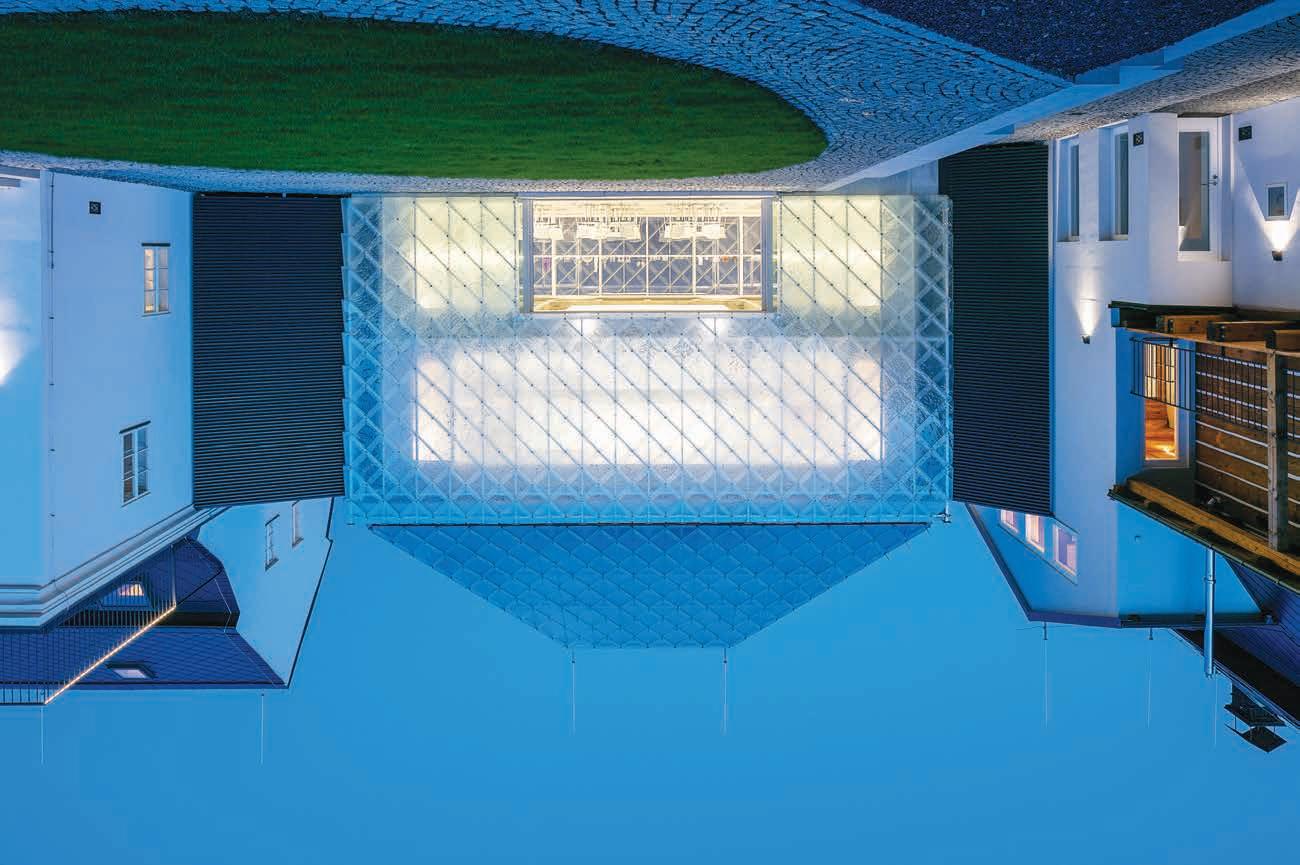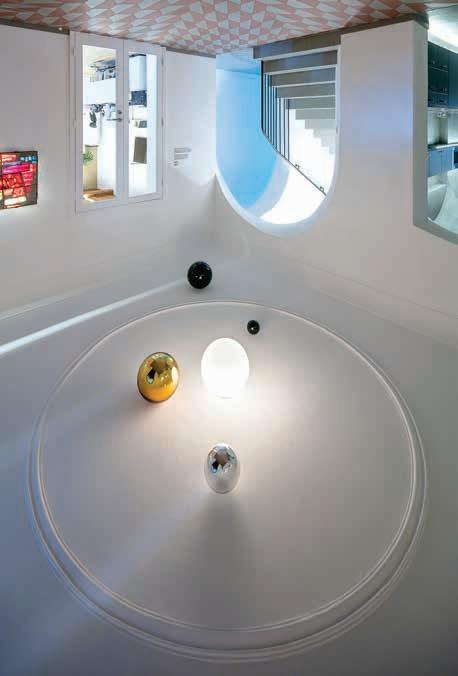
7 minute read
Zamilovaní do skla In love with glass
Unikátní stavební komplex, plný kontrastů poskládaných. do harmonického celku vybudovala v Novém Boru. společnost LASVIT, světově uznávaný výrobce designových. svítidel a skleněných instalací na míru. Má symbolizovat. obnovu sklářství v regionu..
Historické roubenky se snoubí s moderní architekturou. Citlivě obnovené památkově chráněné barokní stavby z roku 1790 doplňuje dvojice nových domů. Černý a skleněný. První jakoby uzavřený do sebe, druhý zářící jako lucerna projasňuje náměstí. „Naše nové sídlo není jen klasickou kanceláří, je ukázkou vize inspirovat svět. Je symbolem naší lásky ke světlu,“ popisuje Leon Jakimič, zakladatel společnosti LASVIT. Domy, které sloužily už před více než 200 lety sklářům a později v nich sídlily sklářská škola a brusírna, se znovu spojily se sklem.
Advertisement
INSPIRACE MINULOSTÍ Nová centrála Lasvitu na Palackého náměstí má i moderní funkční designový interiér. Zaměstnanci v něm našli klid k práci, prostor pro snadnou komunikaci i relaxaci. Budovy, v nichž se potkávají světově uznávaní umělci i designéři, musely navíc splnit i složité technické výzvy.„Například, aby tam bylo možné zákazníkům předvádět desítky metrů dlouhé a tuny vážící skleněné instalace, které dokážou reagovat na hudbu, nebo se pohybovat podle přání klienta v různých světelných podmínkách,“ popisuje mluvčí firmy Jitka Plchová. Do výběru architektonického řešení se zapojil i známý český architekt, popularizátor a kritik architektury Adam Gebrian.
Skleněný dům pokrývají celoplošně skleněné čiré průsvitné tašky. Tvarem a reliéfem připomínají břidlici. LASVIT je vyvinul právě pro tuto stavbu. „Inspirovali jsme se tradiční břidlicovou taškou. Ta se používala na stavbách na Českolipsku dávno v minulosti,“ vysvětluje architekt Štěpán Valouch ze studia OV-architekti, které za projektem stojí. Stejně „nakoso“ je obložený speciální černou cementovou obkladovou taškou i černý dům. Stal se skladem i prostorem k představení nových artefaktů, zatímco skleněný dům je knihovnou vzorků a prostorem pro jednání.
NEKONEČNÁ PŘEKVAPENÍ Už samotný vývoj speciálních skleněných tašek byl složitým procesem, jemuž se architekti museli podřídit. Vedle sklářů do projektu vstupovaly i další okolnosti – legislativa, památková péče nebo statika. „O to větší pak byla radost, když všechno fungovalo,“ přiznává Š. Valouch a vzpomíná, že každý kontrolní den přinesl nějaké překvapení. Jako při většině rekonstrukcí se ukázalo, že skutečný stav domu je horší, než se odhadovalo, že práce půjdou pomaleji, obnova se prodlouží a podraží. „Uvnitř domu jsme narazili na 20 m hlubokou studnu, která nebyla zanesená v žádných záznamech. Nezakryli jsme ji, ale vyzdili a zabudovali do ní osvětlení. Překrývá ji skleněná podlaha a dnes se nad ní odehrávají pracovní schůzky,“ poznamenává architekt.


Skleněný dům svítí do centra města jako lucerna. The Glass House shines into the town centre as would a lantern.
Dalším unikátem je i betonová stropní klenba v zasedačce, kde se vzorky skla čaruje zvenčí prostupující světlo. „Skleněná fasáda přináší velice zajímavé průhledy z nitra,“ potvrzuje Martin Šikola, jednatel LASVIT.
Na rekonstrukci historických částí přispělo vedle Libereckého kraje, kterému objekty před obnovou patřily, i ministerstvo kultury a město Nový Bor. „Mohli jsme postavit něco na zelené louce, bylo by to levnější a rychlejší. My jsme ale chtěli být tady, v centru evropského sklářství, kde to všechno začalo,“ shrnuje L. Jakimič.



SKLENĚNÁ BUDOUCNOST Architekti si na výjimečné stavbě vyzkoušeli, že není třeba se bát experimentů. „Zamilovali jsme se do skla,“ přiznává Štěpán Valouch. A rozhodně není jediným takto smýšlejícím stavitelem. Velkoformátové zasklení se stalo trendem. Až 160 000 m 2 skleněných fasád vyrobí ročně firma Sipral, která dodala plášť pro pařížské výstavní prostory Nadace Louis Vuitton od slavného architekta Franka Gehryho nebo na architektonicky unikátní kodaňskou spalovnu odpadů Amager Bakke. V Česku lze její fasády vidět na pražských projektech Quadrio a Main Point Karlín. Místní skláři umějí vyrobit i opláštění s fotovoltaickými články a ze skleněných tyčí vykouzlit třeba i lavičku. LASVIT obložil sklem v minulosti mnoho vyhlášených rezidencí na celém světě, např. hlavní halu hotelu Bellagio Shanghai i umělecké centrum Kanal – Centre Pompidou v Bruselu.
PETRA LAURIN / FOTO: ARCHIV LASVIT
LASVIT, a globally recognized producer. of designer lighting and made-to-suit. glass installation created, in Nový Bor,. a unique building complex full of contrasts. assembled into a harmonious unit. It is. to symbolise the revitalisation of the glass. industry within the region..
Historic log houses combine with modern architecture. The sensitively reconstructed listed Baroque buildings from 1790 are complemented by two new buildings. A black one and a glazed one. The first is as if enclosed and the other is like a lantern brightening up the square. “Our new headquarters don’t only represent a classic office but a vision to inspire the world. It is a symbol of our love for light,” describes Leon Jakimič, founder of LASVIT. The buildings that have already served glassmakers more than 200 years ago and later as premises for a glass making school and glass cutting workshops were connected with glass again.
INSPIRATION FROM THE PAST The new Lasvit’s headquarters at Palackého Square also have a modern functional design interior. Staff have found peace and quiet for their work there as well as a place for
simple communication and relaxation. The buildings, where globally known artists and designers meet, also had to meet difficult technical challenges. “For instance, to make it possible to show customers dozens of metres long and tons of glazed installations that can respond to music or move in different light conditions at the client’s request,” desicribes Jitka Plchová, spokesperson for the company. The tender for the architectural solution was also entered by the well-known Czech architect, populariser and architecture critic Adam Gebrian.
The glazed house is covered by clear glass tiles. Their shape and relief resemble slate. LASVIT developed them specifically for this building. “We were inspired by the traditional slate tile, which used to be used on buildings in the Czech-Leipzig region long ago,” explains architect Štěpán Valouch from the OV-architekti studio, which is behind the project. The Black House is covered with special black cement tiles in the same ‘slanted’ way. It became a storage place as well as a place for the introduction of new artefacts whilst the Glazed House is a library of samples and a place for meetings.
ENDLESS SURPRISES Only the development of the special glazed tiles was the difficult process that architects had to conform to. Apart from glassmakers, there were other circumstances involved in the project – legislation, historic preservation and structural stability. “All the more was the joy when everything worked,” admits Mr. Valouch remembering that every control day came with some surprises. As it is in the case of most reconstruction, it eventually appeared that the real condition of the building is worse than was estimated, that the work will be slower, revitalization longer and that it will increase costs. “Inside the building, we came across a 20 m deep well, which wasn’t registered in any records. We didn’t cover it but bricked it up and fitted it with lighting. It is covered with a glass floor and is now used as grounds for business meetings,” said the architect. Another unique issue is the concrete ceiling arches in the meeting room where the light that comes in from the outside and does magic with the glass samples. “The glazed façade brings very interesting views from the inside,” confirms Martin Šikola, company director at LASVIT. The reconstruction of the historical sections was contributed to by the Liberec region, which owned the two buildings prior to the revitalisation, as well as the Ministry of Culture and the town of Nový Bor. “We could have built something on green land. It would have been cheaper and faster. But we wanted to be here, in the centre of the European glass industry, where everything started,” summarizes L. Jakimič.
GLAZED FUTURE The architects tried, on this exceptional building, that it is not necessary to be frightened of experiments. “We fell in love with glass,” admits Štěpán Valouch. And he is definitely not the only contractor who thinks so. Large scale glazing has become a trend. The company Sipral, which supplied the sheathing for the exhibitory grounds of the
Unikátní komplex plný kontrastů poskládaných do harmonického celku vybudovala v Novém Boru společnost LASVIT. LASVIT created a unique complex full of contrasts assembled into a harmonious unit in Nový Bor.


Louis Vuitton Foundation in Paris by the famous architect Frank Gehry and the architecturally unique waste incinerator Amager Bakke in Copenhagen makes annually up to 160,000 sq m of glazed facades. As for the Czech Republic, we can see their facades on Prague projects of Quadrio and Main Point Karlín. Local glassmakers can also make sheathing with photovoltaic elements and to, for instance, conjure up a bench from glass poles. LASVIT has sheathed many well-known residences worldwide in the past, for instance the hall of the Bellagio Shanghai Hotel and the art centre Kanal – Centre Pompidou in Brussels.
PETRA LAURIN / PHOTO: LASVIT ARCHIVE
LIGHT MEETS ACOUSTICS











